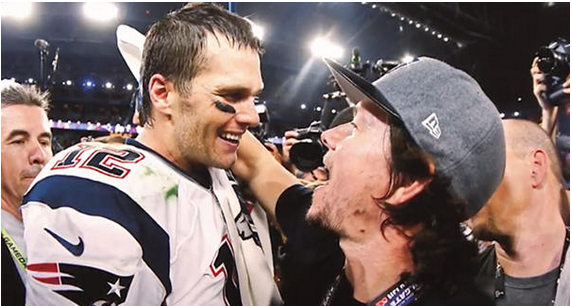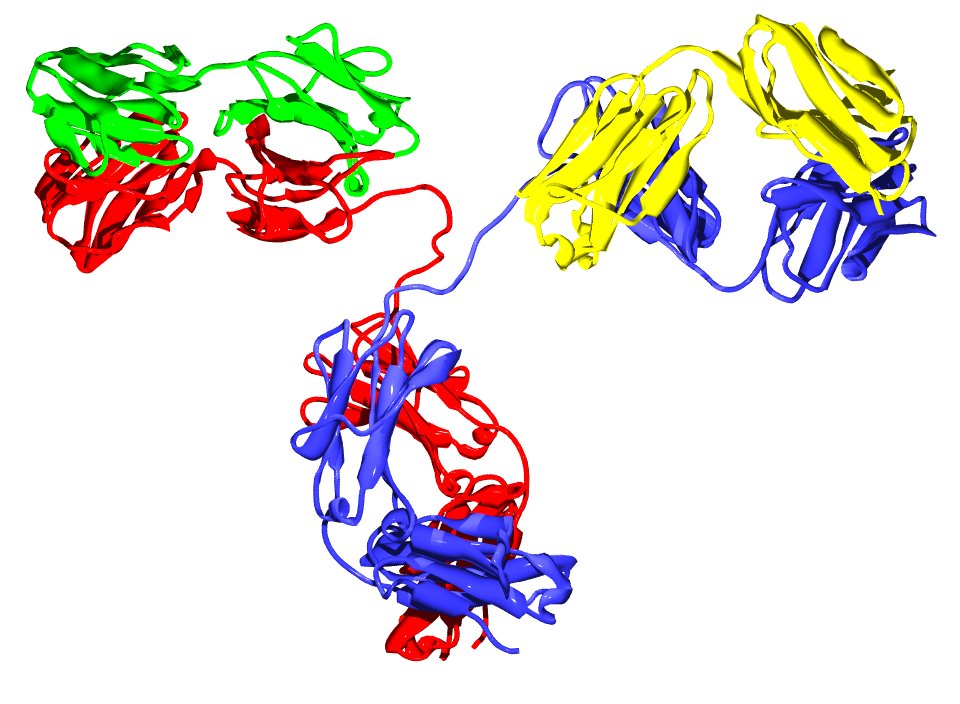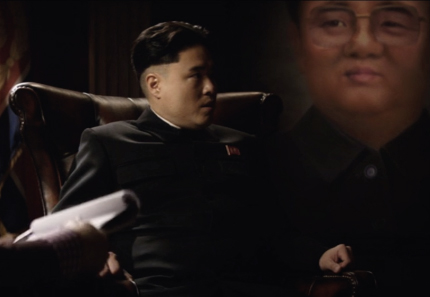Asian/American (Anti-)Bodies
Post-64: Epiphoric Epiphora, the Crying Camry, and Transformers: Age of Extinction
Epiphora in a physiological sense is a superabundant flow of tears.1 In a rhetorical sense, epiphora is the repetition of a word or phrase, usually at the end of a sentence. An "epiphoric epiphora" is thus the rhetorical repetition of a superabundant flow of tears. Although epiphoric epiphoras appear in many contexts, the claim of this essay is that epiphoric epiphoras have particular value as a device for finding a different vantage upon an axiomatic dividing line in Asian American history: the year 1965.
1965 is axiomatic for good reason. Fifty years ago, Lyndon Johnson signed the Immigration and Nationality Act of 1965, which eliminated the 1921 National Origins Formula and opened the door to "post-65" Asian immigration. Although this line has axiomatic value for the study of "Asian Americans" understood as a category of human subjects, the very brightness of this line has had the secondary effect of outshining other events in its immediate temporal vicinity. Turning to these events can illuminate how "Asian American" might be better understood as a category which includes non-human, mechanical objects.
One such event was the 1964 publication of Herbert Marcuse's One-Dimensional Man.2 Historian William Wei claims that this text may have played a formative role for "many young militants" in the Asian American movement because it provided "one of the most comprehensive critiques" of the complex, corrupt, and co-optive institutions of 1960s America's "one-dimensional society."3 However, Asian Americanist scholarship of the last three decades has mostly avoided a sustained engagement with what Angela Davis has called "Marcuse's Legacies."4 Davis observes that, compared to the work of other Frankfurt School scholars such as Theodor Adorno and Walter Benjamin, Marcuse's work is curiously time-locked, "entombed . . . within the history of radical activism during the 1960s" so thoroughly that "[a]cademics and activists alike find it difficult to disassociate Marcuse from the era of the late 1960s and early 1970s."
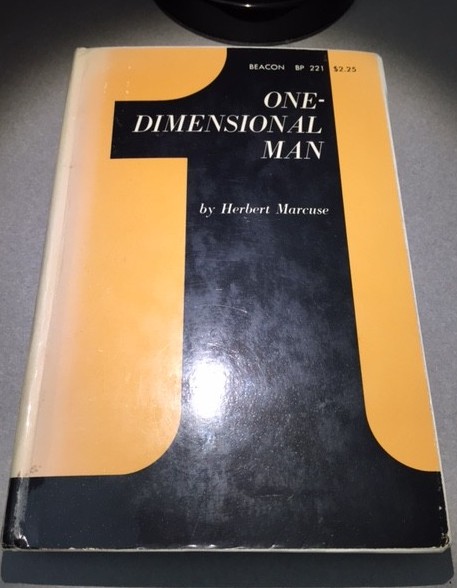
Part of the entombment of Marcuse's work may derive from some of the most central, if controversial, claims in One-Dimensional Man. Namely, that increasing automation in the "technological work-world" had weakened the "negative position of the working class" to such an extent that the proletariat could no longer be relied upon to develop a revolutionary consciousness.5 Advanced industrial societies, as Marcuse understood them, had transformed "the object world into an extension of man's mind and body," making "the very notion of alienation questionable."6 This transformation was achieved through an expansion of mimesis, or technological reproduction of reality, that had so "invaded and whittled down" the "private space" of the individual that the individual's responses were "ossified in almost mechanical reactions."7 In the absence of a proletariat capable of forming class consciousness, it fell to the "substratum of the outcasts and outsiders, the exploited and persecuted of other races and other colors" to articulate a revolutionary opposition.8 This last claim is of obvious, if not formative, relevance to the revolutionary subjects who participated in the Asian American movement of the late 1960s. However, the figure of epiphoric epiphora may prove helpful in providing a way to revisit Marcuse's argument about the transformation of the object world, and in particular, his famous declaration that "[t]he people recognize themselves in their commodities; they find their soul in their automobile . . ."9 Such a line of thought might guide us to thinking about "Asian Americans" not only as human subjects capable or incapable of revolution, but also as non-human objects transformed into extensions of "man's mind and body"-- automobiles with souls. Before turning to ensouled automobiles, however, a brief description of contemporary epiphoric epiphoras is in order.
Five decades after the publication of One-Dimensional Man, there is now a superabundance of ready-to-hand examples of epiphoric epiphoras, an excess which veers from the serious to the ridiculous. The resignation of tear-prone House Speaker John Boehner in October 2015 has raised the prospect of a temporary decline in the supply of epiphoric epiphoras in the national political arena, but there are deep reserves to be found in other cultural sectors. At present, the most widespread epiphoric epiphora is "Michael Jordan Crying," a meme which consists of placing cutouts of Michael Jordan's tear-streaked visage in visual collages of situations captioned with the formula "When X" (e.g. "When the Barber Laughs at Your Hairline"). The Michael Jordan Crying meme is the latest, but likely not the last, iteration of a long-running series of internet memes featuring crying adult men. In rough chronological order, memes generated from stills or clips of television shows or film include "Crying Dawson" (Dawson's Creek, 2000), "Crying Peter Parker" (Spiderman 3, 2007), "Sad Don Draper" (Mad Men, 2010-2014), and "Crying Daryl" (The Walking Dead, 2014).



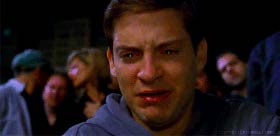
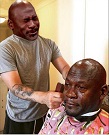

Most of these memes of crying white male actors tend to be in the realm of a mock sympathy, where the viewer is asked to associate how "you" would feel in a given situation with the emotional reaction of the crying man. However, crying meme images of still-active athletes such as LeBron James and Tom Brady tend to function in the realm of antagonistic mockery, where "you," as a non-Cavaliers/Patriots fan, are asked to laugh at an unmanly, finals-losing or ball-deflating, crybaby.

From this torrent of epiphoric epiphoras, Patriot quarterback Tom Brady's epiphoric epiphora provides us with a segue to two debut appearances of ensouled automobiles in recent iterations of the annual mass sporting and advertising event known as the "Superbowl." These are first, a Superbowl XLIX (2015) advertisement for the "New Bold [Toyota] Camry" entitled, "My Bold Dad." And second, Transformers: Age of Extinction — a billion-dollar blockbuster whose first televised trailer appeared in the broadcast of Superbowl XLVIII (2014).

The sixty-second Toyota spot opens with establishing shots of a car driving past the camera at a medium distance, before shifting on the voice-over line — being a dad — to a close-up of the driver/father turning to look at his passenger/daughter, who then appears in reverse shot. The journey of the drive is intercut with flashback vignettes of the father protecting the daughter's passage into young adulthood. Throughout, the dad-voice-over observes — [being a dad] . . . is more than being a father. It's a choice . . . a choice to get hurt, rather than to hurt.

"My Bold Dad" presents an exemplary case of epiphoric epiphora, where repetition of an overflow of tears serves as a means to rhetorically link the crucial segments of the second half of the commercial. After thirty seconds of intercut childhood scenes, a tear appears on the face of the passenger/daughter in the "present" as she "remembers" her rebellious teenage years — her blonde hair dyed black, crying at night in the rain, texting her dad to pick her up (in an older-model Camry) from a party gone wrong. A shot of the father wiping away her tears cuts to the daughter, now a passenger in the present, wiping her own tears. Arriving at the end of the daughter's journey to adulthood (an airport terminal), we see the daughter walking into the terminal through the passenger window, from over the shoulder of the father. The daughter/recruit is wearing a beige military knapsack, and walks into the terminal with several men in combat uniforms. The daughter turns to look back, and we see the father weeping. Over this airport sequence, in voice-over, we hear — [being a dad] is a commitment, one that will make a wonderful human being <pause for dad's tears, cut to daughter smiling and turning away> who will make their [sic] own choices some day. Seeing "tears" in visual counterpoint to the commercial's auditory repetitions of "choice," we come to understand <tears> as the visual manifestation of the protection and reproduction of "choice": the choice "to be more than a father," "to get hurt . . . rather than to hurt," "to be bold, when others are scared," "that says you'll be there, to show them right from wrong."

Without making any claims about the actual effectiveness of the "My Bold Dad" commercial, we can at least surmise what the commercial is trying to do. One can imagine the planning meeting where there might have been a discussion about ways to displace the "dad-car" image of the Toyota Camry into a "new" form of "bold" fatherhood. We can also note how carefully the commercial integrates the product of a Japanese automotive conglomerate to visual enthymemes of American paternalism and patriotism: The daughter has chosen to protect America — our freedom. The dad who has made a choice to be more than a father has also chosen to protect the daughter who protects America. Choose the car that protects them both.
Although "My Bold Dad" could be read as a diegetic commercial — a Bildungswerbung tracing the daughter's development from childhood to maturity — we might better read it as mimetic. The commercial is less a narrative about the young girl becoming an infantrywoman than a repetition of equivalences of being: tears ARE choices, choices ARE tears; Dad IS Camry, Camry IS Dad. As a primarily mimetic device, epiphoric epiphoras make identifying a "choice" on diegetic grounds of history or character particularly difficult. The same car model can produce or protect any kind of "wonderful human being" who will "make their own choices someday."
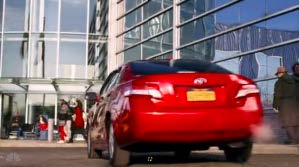
A March 1 Saturday Night Live (SNL) parody calls attention to the formal emptiness in the choices presented in "My Bold Dad." Taking the democratic logic of freedom or "choice" to its furthest extreme, the SNL "Father Daughter Ad" asks: If the father raised the daughter to make her own choices, then how can the father judge her for the specific content of the choices she makes? The parody opens with a minimalist piano accompaniment similar to "My Bold Dad," setting the commercial's sedate rhythmic pace as a red Toyota Camry pulls up to the curb of a bus terminal. Instead of viewing a sequence of costly flashback shots to perfectly timed voice-over, we instead observe an awkward conversation in which "Father" (SNL cast member Taran Killiam) asks "Daughter" (50 Shades of Grey actress Dakota Johnson) if she needs "help with her bag," or "walking-around money."
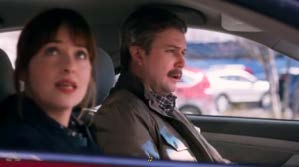

As the daughter promises to be "home for Thanksgiving," her ride appears: a white pick-up truck, emblazoned with the ISIS flag, carrying men armed with machine guns and rocket-propelled grenades. The parody ends with an image of the father in tears as a woman's voice-over reads superimposed text: "ISIS: We'll take it from here, Dad."
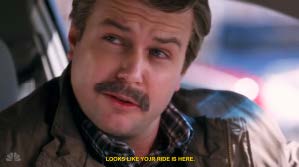
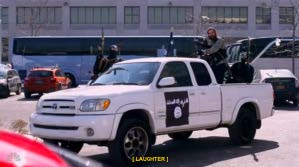

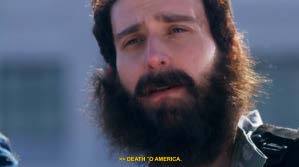

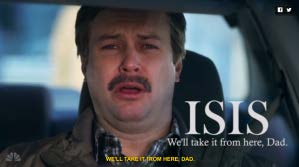
The airing of this parody prompted a flurry of activity on Twitter, in which viewers criticized the ad as at best, being in bad taste, and at worst, as Steve Bucci, director of the Heritage Foundation, tweeted, "draw[ing] a moral equivalence between ISIS murderers and the U.S. military (based on the spoofed commercial)." Bucci's reading of the SNL parody is instructive because it exemplifies a common error in interpretation: the error of confusing formal equivalence with moral equivalence. It is precisely this associative confusion which the Toyota "My Bold Dad" advertisement sought to capitalize upon: linking formal tears with moral choices. The whole point is that there is no intrinsic moral "content" to such linkages. The commercial's empty formula could serve as a vehicle for virtually any tears/choices, up to and including joining ISIS.
At the same time, however, the visual dimensions of the SNL parody depend upon raising the specific and excessive dimensions of the Toyota brand and production. The white pickup which pulls up to the bus terminal is a Toyota pickup, a visual reminder that white Toyota Hilux pick-up trucks have become infamous for being ISIS's "vehicle[s] of choice," as their "lightweight" and "virtually indestructible" frames has made them well suited for modification into "technicals," or improvised fighting vehicles.10 Despite recent protestations of surprise and "clueless[ness]" by American media, government officials, and Toyota itself at how ISIS has come to acquire hundreds of new Toyota light pick-up trucks,11 the trail of open secrets behind this epiphenomenon takes us back, again, to 1964. In January of that year, Lyndon Johnson's Presidential Proclamation 3564, also known as the "Chicken Tax," came into effect. The proclamation, ostensibly crafted in response to the European Economic Community's "unreasonable import restrictions upon imports of poultry," introduced a 25 percent tariff on light trucks. Although the primary rationale for this tariff was likely to protect the American auto industry from having to compete with Volkswagen's popular "Type 2" van and pickup imports, the tariff also affected Japanese light trucks, including Toyota's then-extant Corona and Crown pickups. After introducing the Hilux to the Japanese market in 1968, Toyota developed a plan in 1972 to sell the truck in the United States by exploiting a loophole in the tariff. If the Hilux was shipped in a "cab-chassis" configuration (everything but the cargo "box" or "bed"), then it would be subject to a more reasonable 4 percent tariff.12
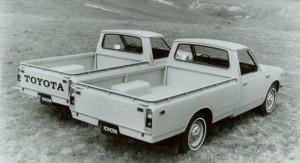
By 1978, Toyota began to advertise the truck in Japanese marketing materials as "born in Japan, raised in the US."13 Although the cab-chassis loophole was closed in 1980, thus curtailing sales of the Hilux in the United States, the "Japanese-American" Hilux had by this time achieved worldwide market penetration. Hilux technicals were the vehicles of choice in the so-called "Toyota War" between Chad and Libya (1986-1987) and in Somalia and Afghanistan during the 1990s and 2000s. In this sense, there is nothing really new about ISIS' acquisition of Hiluxes via any number of channels, whether captured from American-backed Syrian rebels or the Iraqi Army, or stolen from the streets of Australia.14
If the Hilux is "Japanese American" in the sense that it was an object "born in Japan, raised in the US," then we might ask where we might find other such objects. In such a line of thinking, the quintessential "Asian American" example of Marcuse's transformations of the object world are the Transformers, a toy line and media franchise of alien robots created in 1984 through a collaboration between the U.S. company Hasbro and the Japanese company Takara Tomy. Consider how a capsule history of the first, "Generation One" (1984-1990) of the Transformers could be read, as a non-human, object variant of a shin issei (post-45, "new" first generation) Japanese American migration narrative:
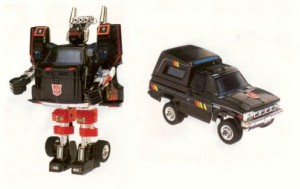
This history begins, yet again, in 1964, with Hasbro's release of the original, 12-inch "G.I. Joe" action figures.15 In 1972, Takara Tomy used Hasbro's "Combat Joe" molds to create Henshin Cyborg, transforming the white-skinned Joe into a clear-bodied cyborg with visible machine innards.16 In 1974, Takara developed a smaller, 3.75-inch "Microman" variant of the Henshin Cyborg. In 1982, the diminutive Micromen returned to the land of their "Combat Joe" ancestor, this time as the template for the "G.I. Joe: A Real American Hero" line. Following the success of this line, in 1984, Hasbro formed a licensing agreement with Takara to market other Microman toys — and an off-shoot line known as "Diaclones"— as "Transformers."17 In sum, the real-world history of the Transformers' Japanese/American "ancestors" recapitulates the Transformers own quite literal and repeated transformations from patriotic (American) humanoids to robotic (alien/Asiatic) mechanoids and vice-versa: from "Combat Joe" to Henshin Cyborg, from Cyborg to Micro Man, from Micro Man to "Real American Hero."

Here is where epiphoric epiphora can provide a means for understanding the broader phenomena that the Transformers index: repeated, post-64 transformations of man-into-machine and machine-into-man. One site for exploring these means is the Transformers' latest cinematic incarnation, the "dazzlingly awful," highest-grossing film of 201418: Transformers: Age of Extinction. Part of the dazzling awfulness of the film is its imperviousness to any form of criticism that begins from such vantages as narrative (diegesis) or development, whether of plot or of character. The film is better understood as a massive exercise in automatic mimesis, which, to recall Marcuse, is an invasion and whittling down of the senses by technological reality.
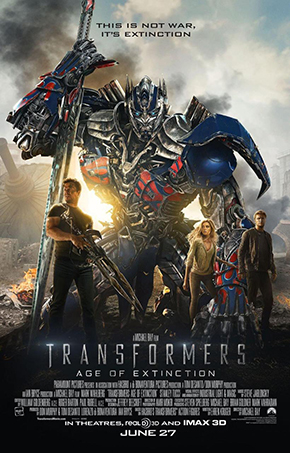
Transformers: Age of Extinction aims to, and often succeeds at, overwhelming the individual viewer with a nearly three-hour onslaught of machine sounds, high-speed chases, CGI explosions, and industrial-scale destruction. Transformers: Age of Extinction is thus a billion dollar, twenty-first century upgrade of the Italian Futurist manifesto of 1909, which found "multicolored, polyphonic tides of revolution" in "arsenals and shipyards blazing with violent electric moons . . . and the sleek flight of planes whose propellers chatter in the wind like banners and seem to cheer like an enthusiastic crowd."19 Whether in 1909 or 2014, automatic, technological mimesis directs revolutionary consciousness into things — planes, trains, and automobiles — producing, in Marcuse's words, an "immediate identification of the individual with his society and, through it, with the society as a whole."20
Thus, instead of thinking about Transformers: Age of Extinction through its all-but-irrelevant plot and characters, we can begin by thinking about its epiphoric rhythm, sonically defined by electronic music producer Skrillex's machine sounds and composer Steve Jablonsky's recurring implementations of the drumbeat of the film's percussive theme-song: Las Vegas rock-band Imagine Dragons' "Battle Cry." Below, I have highlighted the only words in the "Battle Cry" chorus which are not epiphoras.
Nobody can save you now
King is crown, it's do or die
Nobody can save you now
The only sound
It's the battle cry
It's the battle cry
It's the battle cry
Nobody can save you now
It's do or die
The line "king is crown" eliminates the last best hope for a non-epiphoric rhetorical figure in the chorus, dissolving the classic metonym "crown" for "king." (Note that the line "king is crown" line has an uncanny resemblance to the formulation "Dad IS Camry": Camry is an Anglicized version of kamuri (冠) or "crown"). Absent any hope for salvation, the only sound is "the battle cry," the cry "do or die."
While a "battle cry" may not include the kind of crying associated with physiological epiphora — a superabundant flow of tears — Imagine Dragons' performance of the song at the film's Hong Kong world premiere can provide a sense of how the "cry, cry, cry" epiphora attempts to bring the audience into something like the mimesis of "mechanical reactions" and "immediate identification of the individual with . . . society as a whole." During "Battle Cry," the last song of a forty-minute set, lead singer Dan Reynolds seems to struggle with vocal strain as he addresses "Hong Kong," a moment of humanizing vulnerability which only heightens, by contrast, the show's overwhelming percussion and pyrotechnics. Accompanied by a phalanx of Western and Chinese percussionists pounding a military drum beat, punctuated by synchronized fireworks over the entire Hong Kong skyline, the "Battle Cry" finale integrates the "real" (firework) explosions with the cinematic explosions which will destroy much of "Hong Kong" in the film's final half hour of shipyards to skyscrapers battle sequences. Less a wall of sound than a collapse of all sound into "only sound," the finale performance unifies the singer and audience's cry, the drumbeat, the "do or die," the fireworks in the "real" Hong Kong, and the anticipated destruction of the cinematic Hong Kong into one sound.
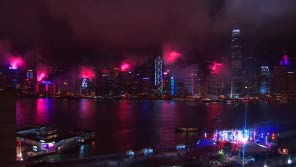
***
This unification also introduces bizarre annihilations of space. The video playing on large screens behind the Imagine Dragons performance opens with a shot of a billboard reading "Remember Chicago" (partially destroyed in the previous Transformers: Dark of the Moon, but sufficiently repaired for its re-destruction to take place at the midpoint of Transformers: Age of Extinction).

This imperative to "remember Chicago" (by reporting "alien activity," no less!) is recapitulated in the film's cinematic destruction of "Hong Kong." Many of the scenes of the destruction of Hong Kong were filmed in landmark landscapes of Chicago (McCormick Place and Damen Silos) and Detroit (Washington Boulevard) making Hong Kong cinematically "one" with the Rust Belt capitals of the American Midwest. The Imagine Dragons/Transformers performance thus exemplifies a mimesis that, as Marcuse would put it, "renders the very notion of alienation questionable," by collapsing whole societies, cities, and levels of reality into "one."
While Imagine Dragons' "Battle Cry" gets us most of the way to "epiphoric epiphoras" in the narrow sense of rhetorical repetitions of physiological tears — to get all the way there we need to make recourse to Mark Wahlberg, the actor called upon to play the part of a single father-inventor who wields an enormous alien gun to protect his seventeen year-old daughter (Nicola Peltz) from a series of rapidly escalating threat cycles. Rather than search in vain for answers within the diegetic universe of Transformers: Age of Extinction, we might instead think mimetically about how Mark Wahlberg's "real-life" post-2010 public image has been integrated with his performance roles.
Over the last four years, Wahlberg's interviews have included a recurrent pattern of boldly presenting himself as a father who cries: from a 2012 disclosure that he cried "seven or eight times" watching The Help21 to a 2014 interview in which Wahlberg describes "crying like a baby" every time he watches (his own film) Lone Survivor.22 The latter interview and the 2014 promotion of Transformers: Age of Extinction took place during Wahlberg's ongoing attempts to secure a pardon from the state of Massachusetts for his 1988 assault and battery of two Vietnamese men, one of whom was a veteran of the South Vietnamese Army.23 The main point here is not to question the emotional sincerity of Wahlberg's tears, but to situate their expression within a broader cultural turn in which tropes of ur-American masculinity and protective fatherhood seem to be figured more and more through the hysterics of epiphoric epiphora: repetitive and superabundant flows of tears.
Although it may seem odd to assert the need for "post-64" Asian American studies as a non-human, object supplement to a human, subject-centered history of "post-65" Asian Americans, the intertwining trajectories which follow from Johnson's Presidential Proclamation 3564, Hasbro's G.I. Joe, and Marcuse's One-Dimensional Man suggest the potential for finding more than meets the eye. Over the waxings and wanings of military-industrial powers — the United States, Japan, and China; through the automatic repetitions of epiphoric epiphora, there is still a need to consider Marcuse's question of how we can find an "opposition" which "violates the rules of the game."24 One such violation might be found in thinking about how to imagine tears, not through endless memes of crying white actors and black athletes, but through the ruptures of Asiatic cyborg bodies, which even if they cannot cry, may at least leak "optical lubricant."25 The Toyota Camry may not quite be an Asian American dad, and it may seem strange to think of other automotive bodies "raised" or manufactured in the United States as Asian American daughters.26 However, epiphoric epiphoras might help us envision the perils and promise of these bodies' Asian American souls.
Andrew Leong is assistant professor of English and Japanese at Northwestern University. A scholar of nineteenth and twentieth century Japanese and American literature, Leong has recently published an article, "The Pocket and the Watch: A Collective Individualist Reading of Japanese American Literature," which appears in Verge: Studies in Global Asias.
References
- I wish to thank Christopher Fan and Sarah Chihaya for their editorial insights. Special thanks are due to Samuel England for bringing the "Father Daughter" Ad to my attention and to Wendy Xin for inspiring the selection of the feature image at top left. I also thank Brian Bouldrey, Jessica Crewe, Kim Icreversi, Ignacio López-Calvo, Shelby Oxenford, Amy Stanley, Marianne Tarcov, Grace Ting and the participants in Alan Tansman's UC Berkeley graduate seminar on Japanese literature for pointing me towards, and guiding me through, many other examples of epiphoric epiphoras.[⤒]
- Herbert Marcuse, One-Dimensional Man: Studies in the Ideology of Advanced Industrial Society (Boston: Beacon Press, 1964).[⤒]
- William Wei, The Asian American Movement (Philadelphia: Temple University Press, 1993), 219n1.[⤒]
- Angela Davis, "Marcuse's Legacies," in Herbert Marcuse: A Critical Reader, eds. John Abromeit and W. Mark Cobb (New York: Routledge, 2004), 43.[⤒]
- Marcuse, 31.[⤒]
- Ibid., 9[⤒]
- Ibid., 10.[⤒]
- Ibid., 256.[⤒]
- Ibid., 9.[⤒]
- Franz-Stefan Gady, "Japan's Largest Company Is ISIS' Car Maker of Choice," The Diplomat October 8, 2015.[⤒]
- Meg Wagner, "Toyota, U.S. clueless about how ISIS got hundreds of brand new pickup trucks," New York Daily News, October 7, 2015.[⤒]
- Ryan Beene, "How U.S. chickens led to Japanese truck plants," Automotive News, June 29, 2015.[⤒]
- "History of the Toyota Hilux," The Official Blog of Toyota Great Britain, March 30, 2015.[⤒]
- Edward Niedermeyer, "Terrorists' Love of Toyotas Is No Mystery," BloombergView, October 9, 2015.[⤒]
- "G.I. Joe (franchise)," Transformers Wiki (TFWIKI.net), Accessed November 9, 2015.[⤒]
- "Micro Heritage: Takara Henshin Cyborg Series (1972-1975)," Microman Forever (microforever.com), Accessed November 9, 2015.[⤒]
- "Classic Microman: Takara Microman Series 1974-1984," Microman Forever (microforever.com), Accessed November 9, 2015.[⤒]
- The film's domestic box office gross was only $245 million. The film's foreign box office gross was $845.97 million, $301 million of which came from Chinese audiences.[⤒]
- F. T. Marinetti, "The Founding and Manifesto of Futurism," in Futurism: An Anthology, eds. Lawrence Rainey, Christine Poggi, Laura Wittman (New Haven: Yale University Press, 2009/1909), 51.[⤒]
- Marcuse, 10.[⤒]
- Lori Berger, "He-man? Ha! Says Mark Wahlberg," Redbookmag.com, February 1, 2012.[⤒]
- "Mark Wahlberg weeps at Lone Survivor," Sunday Express, February 20, 2014.[⤒]
- Rachel McGrath, "Mark Wahlberg's petition to have criminal record wiped clean remains on hold in his home state of Massachusetts," Daily Mail (UK), April 10, 2015.[⤒]
- Marcuse, 257.[⤒]
- "Humanization," Transformers Wiki (TFWIKI.net), Accessed November 9, 2015.[⤒]
- U.S. Camrys are currently manufactured in Indiana and Kentucky.[⤒]
